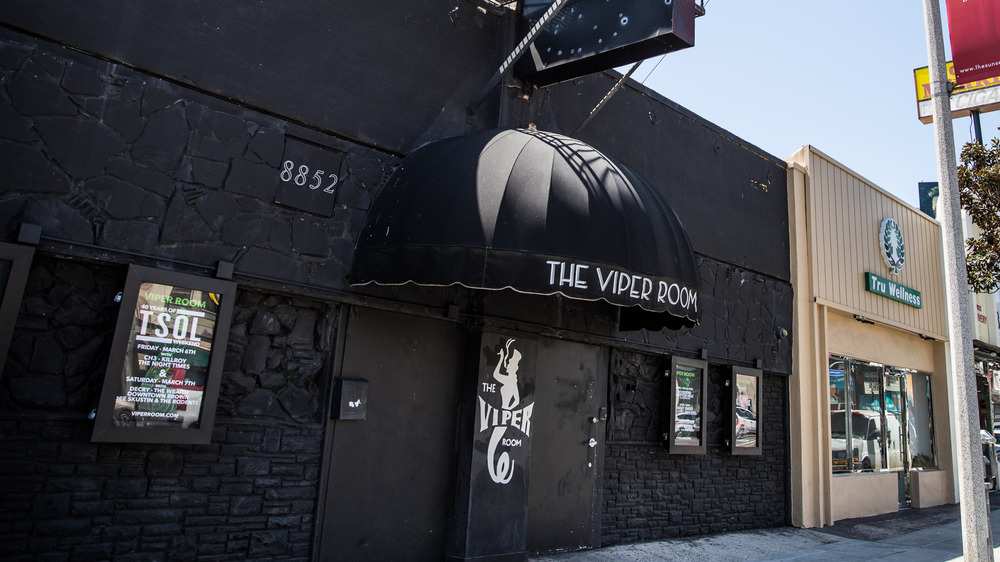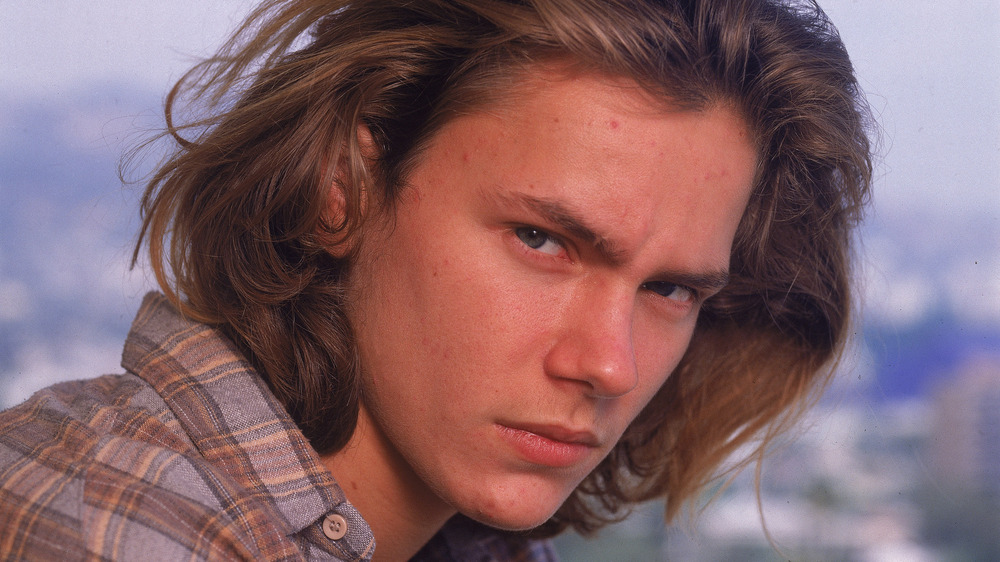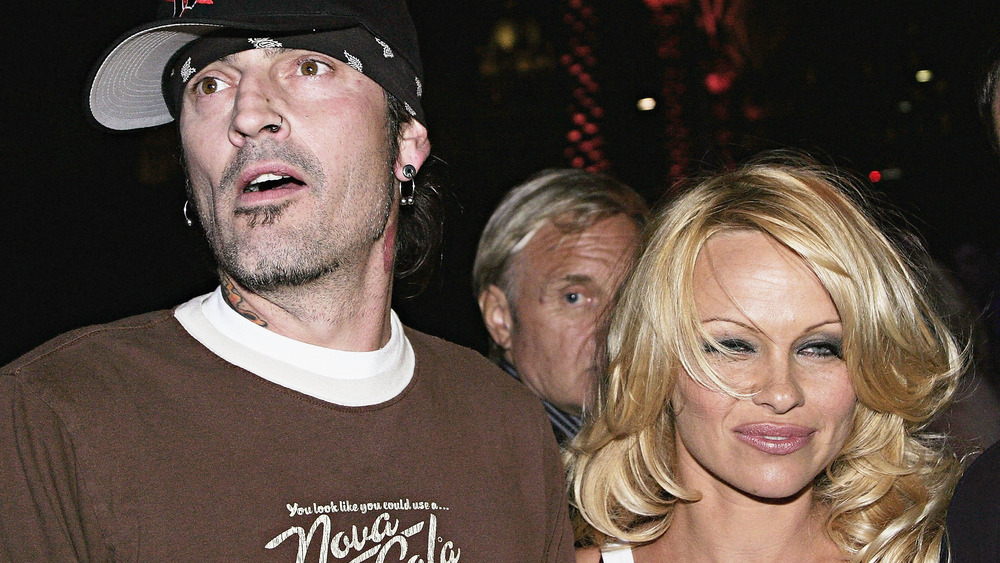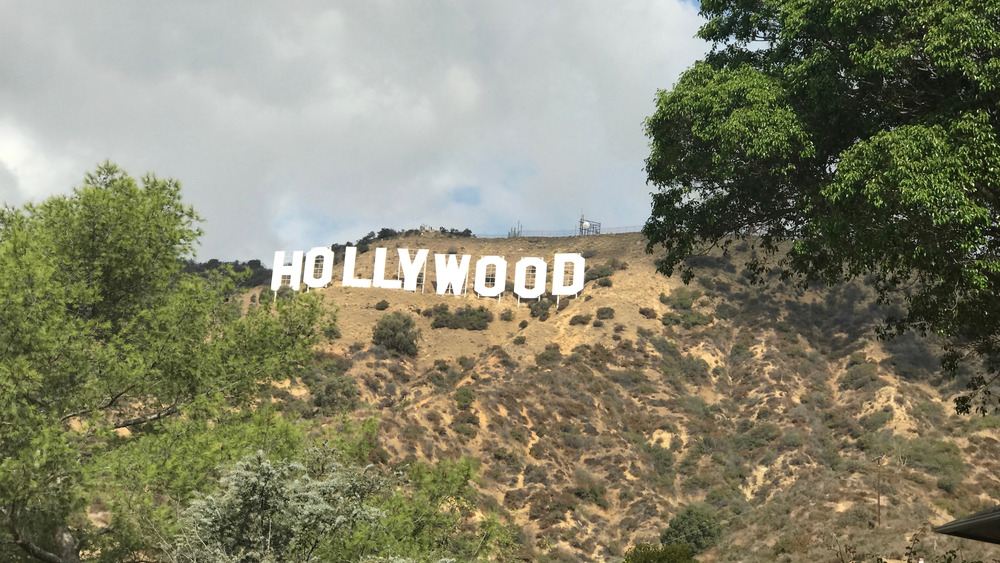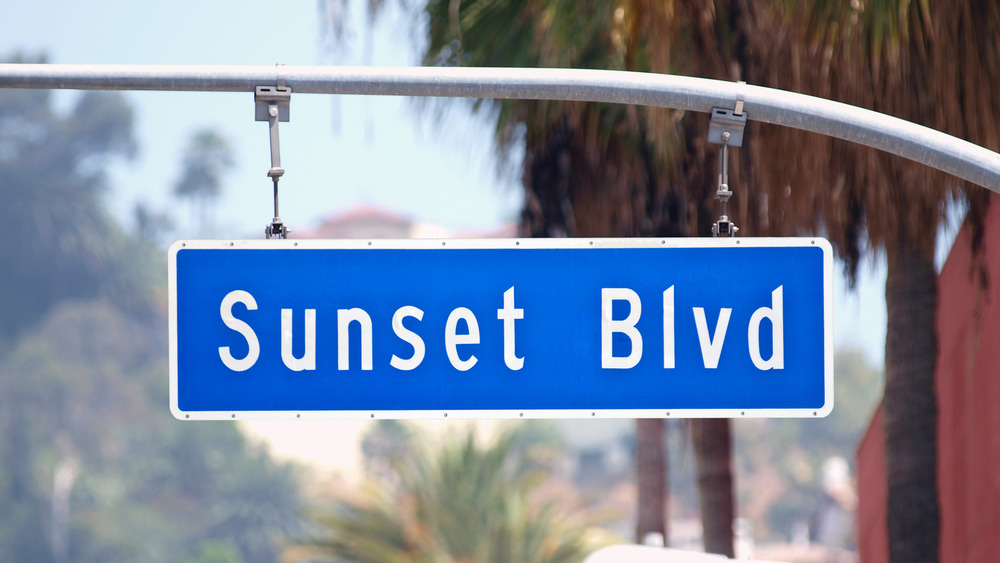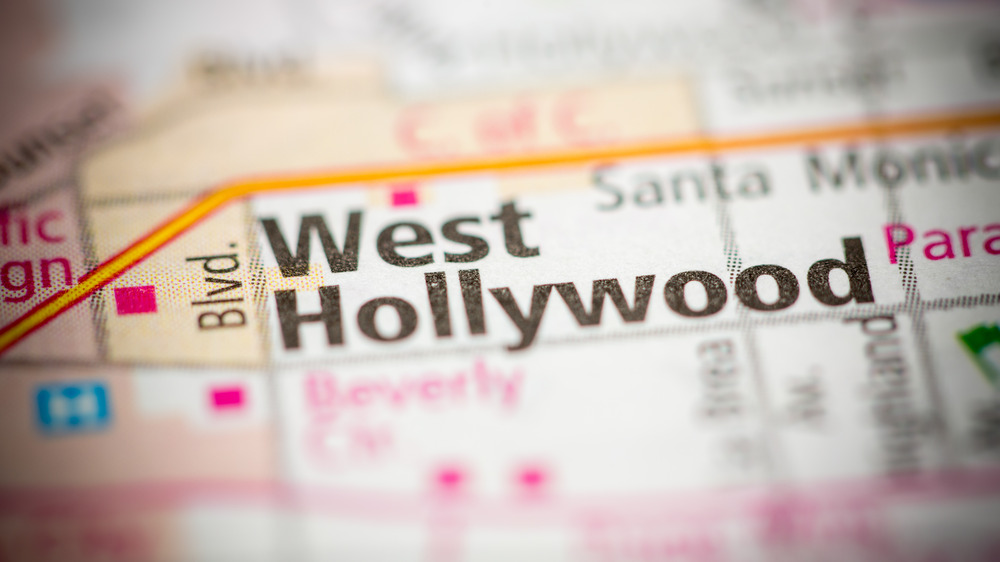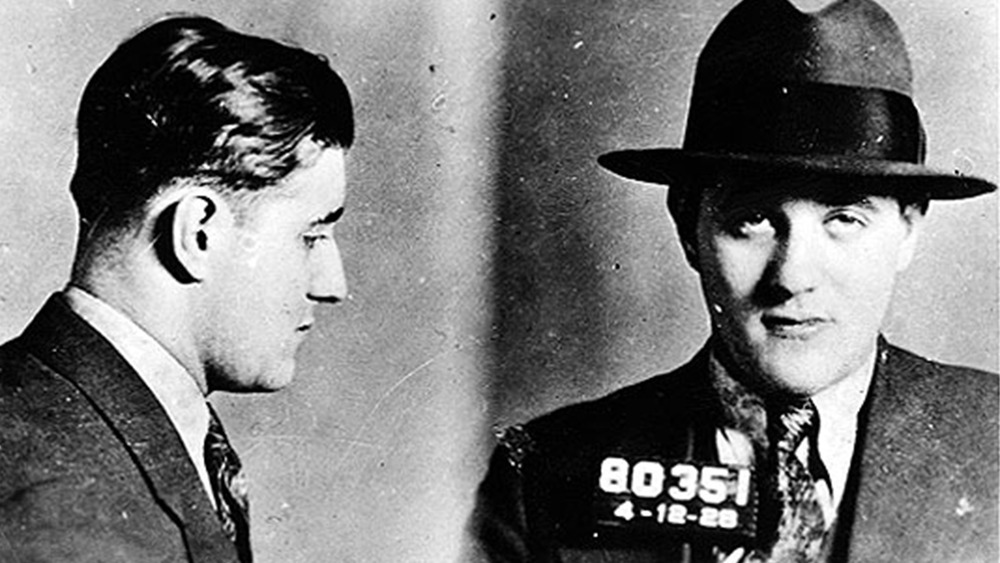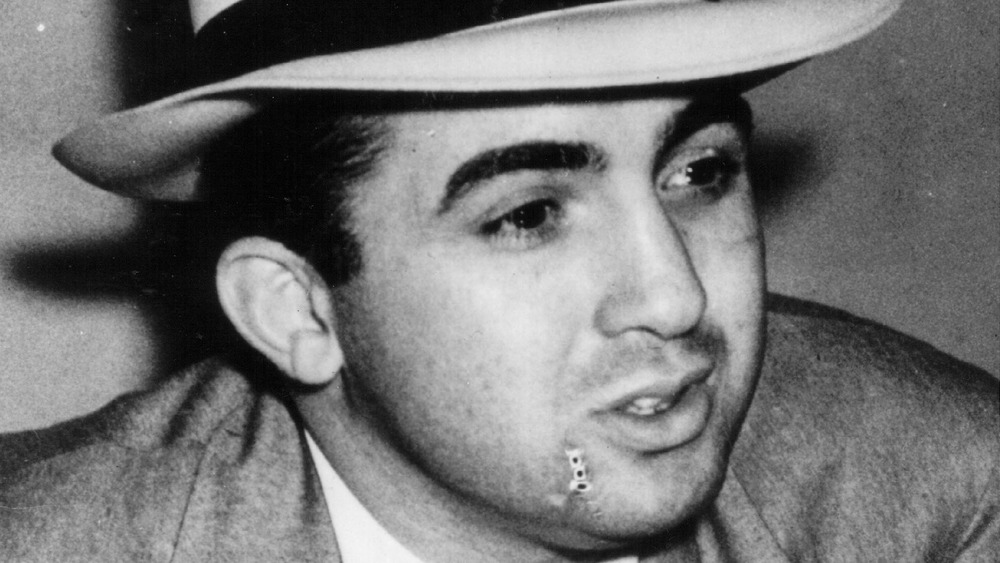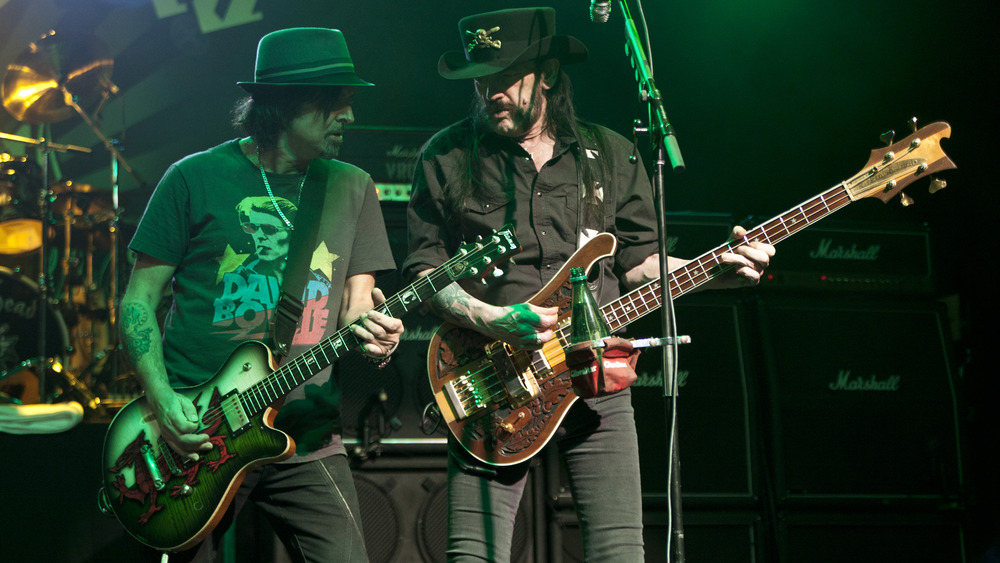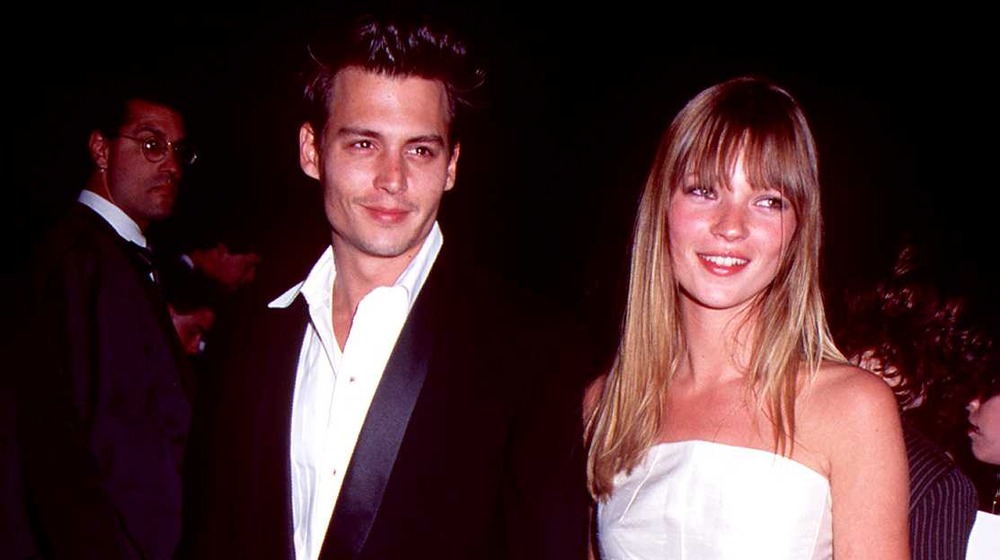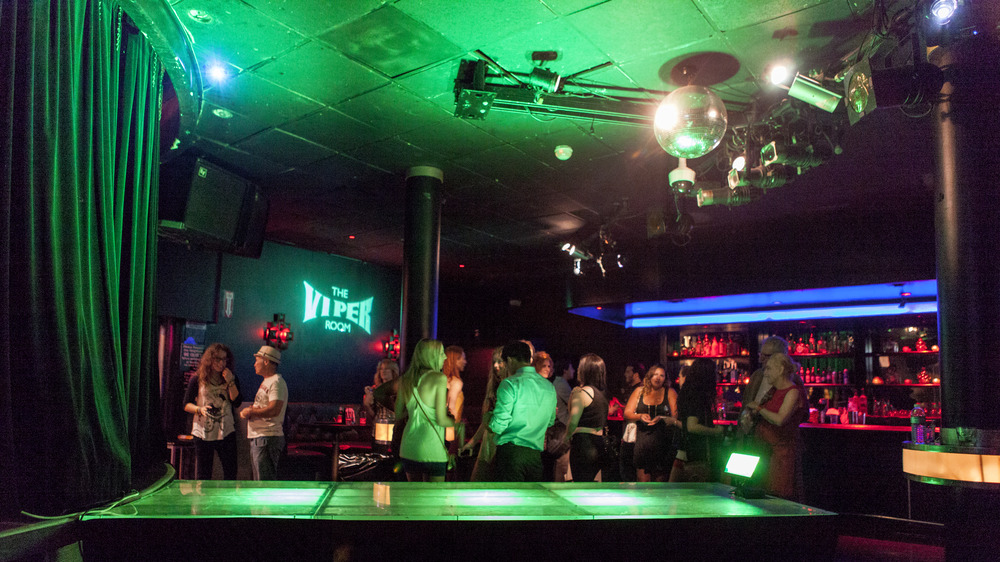Messed Up Things That Happened At The Viper Room
In the early 1990s, no hotter ticket existed than the Viper Room on West Hollywood's notorious Sunset Strip. Owned by Johnny Depp and Sal Jenco of 21 Jump Street (via the Los Angeles Times), bartenders included Adam Duritz of Counting Crows. In an interview with USA Today, Duritz recalls continuing to work at the Viper Room after hitting it big because of the happening scene.
Local bands, from the Red Hot Chili Peppers to the Pussycat Dolls, made it their spot, according to Variety. If one could hop in a time-traveling DeLorean DMC-12, a night at this divey hotspot might yield a tete-a-tete with young celebs like Drew Barrymore, Jennifer Aniston, or Uma Thurman — chokers, flannel, and all.
Of course, times have changed since the club's height, and events have made for a precarious future. But no matter what becomes of the Viper Room down the road, one thing's for sure. Few spots in Los Angeles have played witness to more messed-up happenings. Although the building started as an innocuous blue-collar grocery store, it would rise to infamy two decades later as a notorious gangster hangout and strip club.
But if you assume the past holds the Viper Room's seediest episodes, think again. From drug overdoses to violent scuffles, illegal poker games to whispers of murder, the past two decades have yielded up some of the club's most shocking and salacious rumors, thanks to the Hollywood big names frequenting the joint.
An edgy club with a tragic beginning
Few nights proved more happening than Aug. 14, 1993, on the south side of the Sunset Strip. It marked the launch of Johnny Depp and his business partners' Viper Room, the site of some of the most notorious happenings in Los Angeles. But few in attendance could've predicted the future of the smoke-filled joint, as Tom Petty and the Heartbreakers inaugurated the location.
Soon, the Viper Room's siren call attracted a steady stream of A-Listers and music legends. But a tragic event brought the club permanent infamy just two-and-a-half months after opening. On Oct. 31, 1993, actor River Phoenix went into convulsions on the sidewalk in front of the club, suffering an overdose due to lethal levels of cocaine and morphine. Samantha Mathis, Phoenix's girlfriend, and his siblings, Rain and Leaf (a.k.a. Joaquin), witnessed the heartbreaking event, reports The Guardian, unable to save him despite CPR and a call to 911.
Known as the "vegan James Dean," Phoenix's untimely death shocked many who celebrated the actor as an emblem of healthy living and environmentalism. Following the tragic event, Depp closed the Viper Room every October 31 in commemoration of Phoenix's death, reports LA Magazine. And Hollywood tours still stop to point out the spot where the tragedy took place.
Despite the much-publicized death, the Viper Room persisted as a star-studded hangout throughout the 1990s and early 2000s. Over the years, it attracted a steady crowd of recognizable faces, including Uma Thurman, Mick Jagger, Tommy Lee, Pamela Anderson, Charlize Theron, Pink, Juliette Lewis, Cameron Diaz, and more.
A celebrated rock 'n' roll dive
Two theories have circulated about how the Viper Room got its name. Both have origins in the New Orleans jazz scene of the 1920s and 1930s. Some say Johnny Depp named the place after a Louisiana jazz club, and others say it refers to pot-smoking jazz musicians of that era. The most famous of these vipers, Louis Armstrong, peppered songs with the term, including 1928's "Muggles," as did Cab Calloway in his iconic "Reefer Man" from 1932 (via Jazziz).
Despite allusions to the New Orleans jazz scene, the Viper Room catered to rock and metal bands, both well-known and obscure, with a few notable exceptions. The club earned a reputation for being one of the few places where the audience often proved more famous than the entertainers. But big names made appearances, too. The mid-1990s and early 2000s proved an especially vibrant time for performers, including Stone Temple Pilots, Pearl Jam, Green Day, Oasis, the Red Hot Chili Peppers, Run-DMC, Counting Crows, Johnny Cash, and the Pussycat Dolls.
But according to the Chicago Tribune, a violent scuffle would put a negative spotlight on the Viper Room on Sept. 29, 1996. Mötley Crüe drummer, Tommy Lee, and his "Baywatch" beauty, Pamela Lee, had an altercation involving paparazzi outside the club. According to witnesses, a tabloid cameraman bore the brunt of the attack after Lee allegedly threw him to the ground, damaging the man's hip. Caught on tape, Lee would later settle the lawsuit, according to Deseret News.
From grocery store to gangster hangout
The Viper Room's role in rock 'n' roll debauchery gets all the attention. But the building boasts a rich heritage as one of the oldest commercial buildings on the Sunset Strip, erected in 1921. Historic documents compiled by West Hollywood's Historic Preservation Commission show that a grocery store named Young's Market originally occupied the site at 8852 Sunset, supplying the inhabitants of Sherman, a blue-collar railroad community down the hill.
By the late 1920s, the market, neighborhood, and winding "County Strip" thoroughfare became the site of transformation, according to Playground to the Stars. It grew from a farm-to-market route into a vital artery connecting Hollywood to Beverly Hills. Daily traffic increases justified paving the highway as the surrounding neighborhood evolved into a celebrity playground.
Directors, producers, and silver screen stars demanded luxuries and depravities alike, from exclusive boutiques to high-end cafes, gambling halls to alcohol-fueled speakeasies. The Sunset Strip was born. How could local business owners get away with the mischief? LA Curbed reports that the 1.7-mile stretch of Sunset Boulevard comprising the strip lay in an unincorporated region of Los Angeles County, outside of L.A. Police Department jurisdiction.
The location invited vice. As early as the 1920s, nightclubs and casinos took advantage of this legal limbo, providing the perfect foothold for gangsters. At the same time, an increasing collection of brazen establishments drew Hollywood crowds. Although illegal in the city of Los Angeles, gambling flourished on the Sunset Strip. And during Prohibition, the back rooms of local businesses never quit pouring booze.
Heading up a Hollywood controversy
By June 1946, the grocery store vanished, replaced by the Cotton Club, an establishment that made no bones about attracting and entertaining America's most notorious criminals. Billed as "Harlem in Hollywood," the club featured an "All-Star Show." But as Playground to the Stars points out, despite the evocative name, the Cotton Club had no connection to the wildly famous operation in Manhattan.
The Cotton Club enjoyed a limited run. By mid-1947, it permanently shuttered, making way for a new venue, the Greenwich Village Inn, as confirmed by historic archives located at University of Southern California Libraries. Like the Cotton Club, the Greenwich Village Inn bore a famous name — a callback to the Greenwich Village Café located in the 1920's Christie Hotel (the first "modern" luxury hotel, according to the Los Angeles Times).
What could you expect from a night at the Greenwich Village Inn? On the surface, everything looked tame. Advertisements urged visitors to "Take a Trip to the Strip" for entertainment by the Phil Moore Four. By today's standards, the Phil Moore Four marked a veritable yawn-fest, promising "Music with a Sweet Beat," and likely equally "Sweet Dreams." But despite the benign sound of Phil and the Fours' show, the Greenwich Village Inn found itself, along with seven other Hollywood hotspots, embroiled in a statewide scandal.
The underground scene explodes in West Hollywood
In the late 1940s, Los Angeles experienced significant growth during the post-World War II manufacturing boom. The city's growing pains came with a resurgence of interest in the unincorporated Sunset Strip's dealings and increasing public scrutiny. As stories of West Hollywood's mayhem and debauchery reached the ears of legislators, the Greenwich Village Inn became the epicenter of the action.
From Sacramento, the California Legislature dispatched the Subcommittee on Public Morals to the scene, writes Playground to the Stars. The subcommittee ruled that all eight Sunset Strip establishments should have their liquor licenses revoked due to "indecent, lewd, and lascivious entertainment." They also argued that the businesses offered hangouts for immoral and perverted individuals.
Besides the Greenwich, businesses involved in the controversy included La Brea Avenue's Flamingo, known for its drag shows. The Café Continentale, associated with East Coast mobster Mickey Cohen and located on Santa Monica, also came under fire, as did Billy Berg's on Vine, where jazz legends such as Billie Holiday crooned. Old-time gambler Slim Gordon's Hollywood Boulevard club also felt the heat, as did three other less-than-savory establishments located on the same stretch of turf, the Susie-Q, Bradley's, and the Swing Club.
From building fires to strip-capades and drag shows
Despite the hullabaloo, the subcommittee's recommendations went unheeded for one very intimidating reason — the influence of organized criminals, including Bugsy Siegel and Mickey Cohen. Mobsters held the Sunset Strip in their grip, making money hand-over-fist from illegal prostitution, drug sales, and illegal gambling, all while offering financial incentives to local law enforcement who looked the other way.
By the decade's end, the Greenwich Village Inn closed, and the Rue Angel briefly filled its spot. But a fire engulfed the rear of the building on Jan. 9, 1950, causing $10,000 in damages, writes Playground to the Stars. According to Dollar Times, that's the equivalent of more than $110,000 in 2021. Some people speculated in-fighting between gangsters produced the mysterious blaze. Whatever the cause, it spelled the end for the Rue Angel, which succumbed to heavy smoke, water, and flame damage.
By September 1950, the modest building reopened as the Last Call, a strip club specializing in a "Rendezvous of the Stars" and "Strip-Capades." The "Strip-Capades" represented uninterrupted, risqué marathons five hours in length and seven days per week. A runway in the middle of the club permitted dancers to stray throughout the audience performing.
The Sunset Strip openly snubbed its nose at the early 1930s ban on strip clubs in Los Angeles. But everything changed in 1951, when local officials folded to pressure to bring the Strip's laws into synch with that of the city. Newfound respect for the law meant a "last call" for the Last Call, which closed due to "lewd and lascivious" shows, likely featuring drag queens, on April 5, 1951.
The Melody Room and Mickey Cohen
The day after the Last Call closed, Mickey Cohen received an indictment on charges of tax evasion. Coupled with the infamous hit on Bugsy Siegel a few years earlier in 1947, this meant an end to the stranglehold the mafia had over West Hollywood.
From 1951 to 1969, 8852 Sunset operated as The Melody Room, owned by brothers Pete and Billy Snyder, according to Visit West Hollywood. On Dec. 26, 1952, another salacious event took place on the sidewalk in front of the building. Law enforcement arrested Sam Farkas, Mickey Cohen's bodyguard, according to the Green Bench Monthly, on suspicion of robbery.
Farkas could no longer look to Cohen for protection. After all, his former boss was dogged by law enforcement and in and out of prison on charges of tax evasion. But the charges against Farkas would be dropped, and in 1958, he married the mob boss' ex-wife, Lavon (a.k.a. Simoni King), a former sex worker and madam.
Many people associate 8852 Sunset with Cohen's headquarters, Michael's Exclusive Haberdashery, although the haberdashery sat one block east at 8804 Sunset. As for the Melody Room? The next 18 years saw its rise as a mainstay of the L.A. music scene, featuring performances by Billy Ward and the Dominoes, Bobby Troup, Bobby Short, and many more.
The primrose path to rock 'n' roll mayhem
In 1973, 8852 Sunset embraced a rock vibe as Filthy McNasty's, enjoying a long line of fascinating clientele, reports Wehoville. The eponymous nightclub paid homage to West Hollywood's most eclectic character, Filthy McNasty, a true man about town. Besides the lounge, McNasty and his brother also owned the F.M. Station club.
Born Wilfried Bartsch in Berlin, McNasty and his brother, Wolfgang, relocated to America in 1956, finding work in the restaurant business before acquiring and revamping the Melody Lounge. As Filthy McNasty's, the establishment attracted eclectic public figures like Elvis Presley, Phyllis Diller, Mick Jagger, Evel Knievel, and Tom Waits.
After banning photography at the club, John Wayne and Little Richard also made appearances. When nights wound down at Filthy McNasty's, celebs relocated to the F.M. Station in North Hollywood, where festivities continued into the wee hours to live performances by Kiss, Guns and Roses, Great White, Motorhead, Metallica, and Mötley Crüe.
As recounted by Visit West Hollywood, the 1980s saw yet another reinvention of 8852 Sunset as the Central, frequented by John Belushi, Rickie Lee Jones, John Entwhistle of The Who, and C.C. DeVille of Poison. Filthy McNasty's and the Central effectively set the stage for the mayhem of the 1990s and 2000s, with the Viper Room acting as a harbinger of hard music, illicit drug use, and illegal gambling.
A model's birthday party turns into drug-fueled debauchery
A year-and-half after River Phoenix's tragic death outside the Viper Room, another dark episode unfolded, involving Australian singer Jason Donovan. Like Phoenix, Donovan maintained a clean-cut image. But unlike Phoenix, he regularly used cocaine.
Nevertheless, Donovan managed to keep his dependency a secret until receiving an invitation from Johnny Depp to then-girlfriend Kate Moss' 21st birthday in 1995. Although photos of the hedonistic event prove rare, tales (and fashion) from the party remain the stuff of legends, according to Vogue. During the party, Donovan overdosed on cocaine with nearly fatal consequences.
According to his autobiography, Between the Lines: My Story Uncut, as highlighted in The Mirror, Donovan had a near-death experience at the Viper Room after succumbing to cocaine-induced seizures. "My heart was racing, my vision was blurring and I was becoming disorientated. I tried to steady myself but my legs buckled under me and I fell to the floor."
Despite blacking out and getting rushed to the hospital, Donovan survived the brush with fate. Taken to Cedars-Sinai Medical Center, Donovan found himself at the same facility where Phoenix had been pronounced dead. Yet, Donovan would make a recovery, getting released from the hospital three hours later.
The mysterious disappearance of a co-owner
In 2001, Johnny Depp found himself embroiled in a multi-million-dollar lawsuit launched by one of his Viper Room business partners, Anthony Fox, according to Medium. Fox accused Depp and four other partners of conspiring to defraud the club of millions.
Just days before Fox was scheduled to testify in late 2001, The Charley Project reports that Fox went missing along with a .38 caliber revolver and his pickup truck. On Jan. 6, 2002, Fox's vehicle turned up, abandoned in Santa Clara, Calif., approximately 330 miles from Fox's Ventura residence. Over the years, speculation has run wild about Depp's supposed role in the disappearance, as well as the possibility of murder. Without a body and minimal evidence, the case remains cold.
In 2004, Depp signed over his share in the Viper Room to Fox's daughter, Amanda, who sold it in 2008 (via NME). But the illicit activities at the Viper Room wouldn't come to an end with Depp out of the picture.
Playing host to Hollywood's highest-stakes poker night
Beginning in 2005, the Viper Room housed some of Hollywood's highest-stakes poker games (via Time), with buy-ins starting at $5,000 and often going much higher. The games took place downstairs, overseen by Molly Bloom, a 26-year-old cocktail waitress. According to an article in Vanity Fair penned by Bloom, she soon took full control of the high-profile games, becoming the mastermind of the operation and inspiring 2017's Molly's Game, starring Jessica Chastain.
But not all participants of these underground celeb poker games agrees with Bloom's take on the scene. Regular attendee and card aficionado, Houston Curtis tells it differently in his book, Billion Dollar Hollywood Heist, as highlighted by the New York Post. Curtis claims Tobey Maguire staged the illegal games. Together, Maguire and Curtis allegedly hand-picked players, eventually making off with millions. Maguire won nearly every week, and according to Curtis, they used Leonardo DiCaprio (unbeknownst to him) as a lure to draw other players. Curtis claims he and Maguire used Bloom as a distraction so that players wouldn't get alarmed by their losses at the table.
While which account proves true may never be known, players supposedly included Ben Affleck, Matt Damon, A-Rod, the Olsen twins, and Matt Damon. Eventually, events moved to other locations like the Beverly Hills Hotel before coming to a halt after Bloom's arrest in 2013. But the so-called "Poker Princess" ducked prison time, according to the New York Daily News, and still fondly recalls her lucky break at the Viper Room.
Last call at the Viper Room
In 2018, the Los Angeles Business Journal reported that the Viper Room sold along with three other Sunset Strip properties for a whopping $80 million to REM Finance, Inc., of Scottsdale, Ariz. Properties included the blocks of 8850 to 8860 Sunset Boulevard and 8874 to 8878 Sunset Boulevard. The properties total 38,000 square feet of land and 16,000 square feet of parking space, an attractive location for development in an otherwise land-poor city.
According to Jimmy Cooper, a director at REM Finance, no demolition or development plans currently exist for the site. Cooper says the company continues to research the "highest and best use" of the property. Some locals fear the worst, an encounter with the wrecking ball.
A recent slew of development projects along Sunset Boulevard has further exacerbated these concerns. These construction projects include hotels such as the Edition, the Jeremy, and a planned Arts Club owned by Gwyneth Paltrow, as showcased by Architectural Digest. But perhaps the nail in the coffin remains the fact that trendy bands and A-List celebs grace the club less often these days. The Viper Room does, however, remain open — a tantalizing relic of Sunset Strip's debauched and colorful history.
